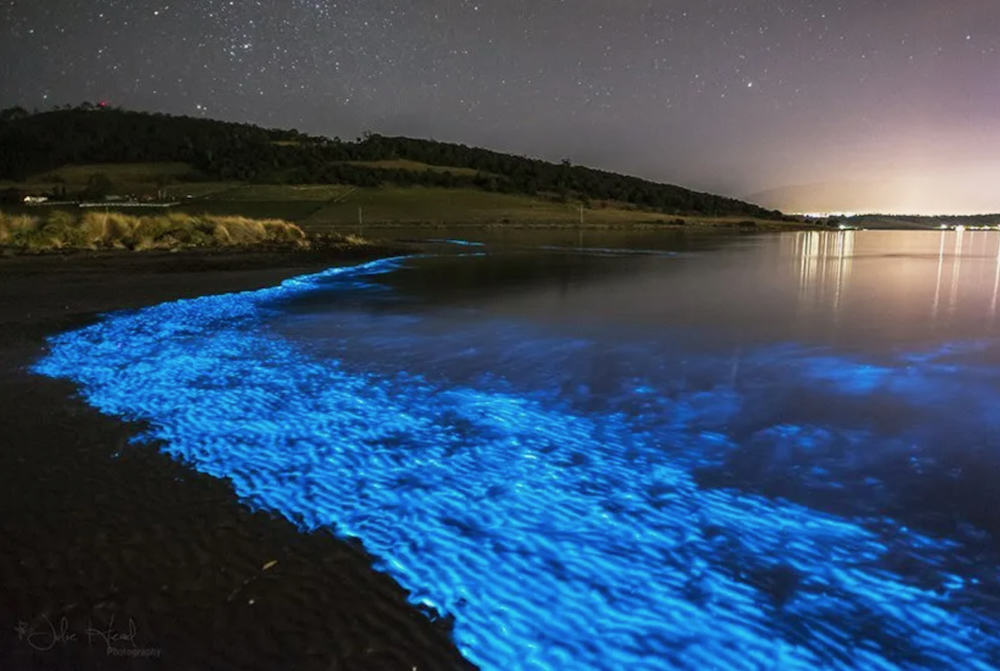 L. Acadia
L. Acadia
Noctiluca scintillans (蓝眼泪)
Charting sine waves of
………………………………sun angles
………….tide cycles
…………………….UV indexes
……screaming beachgoers
we calculate 美人沙灘 Beauty Beach’s perfect snorkel hour
dodging reef-flat turtle-traffic
……there are fines for touching
navigate canyons so vibrant with reef fish
we cannot just float weightless on the surface,
must be diving down through
………………………………………….lion
………….trigger
……………………..butterfly
………………………………..massive puffer fish,
see
…………weird green mantis shrimp,
…..eels seeming to sing,
……………………just the antennae of something,
hear
………….parrotfish chomping coral skeletons,
………………..a distant motor
ponder
trumpet fish swimming proudly vertical,
flotillas of squid defying physics,
a fading blue-white octopus defending its cave
Then we
spot
a stingray, follow it out over a sandy bottom
bare knees scrape
crinoids catch our rash guards
A chameleon,
that ray morphs into a cephalopod
pulling us by masks now
filling with saltwater
we try to empty, but
there’s no air left
in our lungs
to clear
water
from our snorkel masks
no strength left
Waves swirl us into the cave, we
see
neon nudibranchs and
Mother Goddess Matsu’s
blue tears
before blackness
__________________________________________________
L. Acadia is a lit professor at National Taiwan University and best-of-the-net-nominated member of the Taipei Poetry Collective, with speculative poetry in Dreams & Nightmares, Eye to the Telescope, Strange Horizons, trampset, and elsewhere. Connect on X and Instagram: @acadialogue
Author’s Notes and Backstory: On the boat I nearly missed, I sketched out a draft of this poem, trying to account for the force I struggled against to leave the water. I was visiting 小琉球 with my partner and two friends, one of whom is writing a book on marine law and Dutch imperialism, so our conversations had swum with genocide and environmental destruction, with the island’s life and ghosts. This final morning, the biodiversity and the seeming eye-to-eye interactions with the sea creatures we encountered seemed unreal. As a diver, I often have the impulse when snorkeling to descend, forgetting my reliance on tube not tank. This snorkel, it was more than habit pulling me down beyond the limits of my breath.
Formally, the enjambement and functional white of the poem are meant to pace the reading to emphasize breath, and also to evoke descent to depth leading to the final line of drowning oblivion. The poem’s title combines two names for a bioluminescent dinoflagellate common in the waters around Taiwan: the Latin binomial name, ‘Noctiluca scintillans,’ and Mandarin common name ‘蓝眼泪,’ literally ‘blue tears,’ evoking the other common name, ‘Matsu’s tears.’ Matsu is a northern Taiwanese archipelago named for a deified human, the clever daughter of a fishing family, who in life and afterlife helped people survive the sea. In local lore, she also caught WWII US bombs before they could explode. Sea Goddess Matsu is a benevolent protective force, so with her tears, I hoped not only to allude to the bioluminescent displays Taiwan enjoys in late Spring, but also to suggest failure. The narrator is drowning, yet in an era of coral bleaching and industrial trawling, one death on the reef serves as a synecdoche for broader devastation.
Editor’s Comments and Image Citations: Noctiluca scintillans is a microalgae known as ‘sea sparkle’ that emits a bioluminescent blue glow when disturbed at night. Image is from Australian Geographic: Hobart, Tasmania on the Derwent River. [https://www.australiangeographic.com.au/topics/science-environment/2024/11/takayna-tarkine/]
